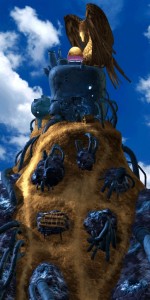Unused Fields of FFVII

The FIELD folder in the retail editions of Final Fantasy VII hold maps which are never accessed in a normal playthrough. They either require modding tools in order to be visited or have so little data that they do not have a complete area to load. This article is about those fields.
Some maps have been explored (or will be explored) in the Unused Text Series, and sometimes those articles will be linked to from here. The maps in this feature were omitted from the Unused Text Series due to containing no text that was readable via the Makou Reactor software.
A foreword about the debug rooms and the general map file structure is necessary for a full appreciation of what shall be presented. Let’s mosey! Uh, I mean, LET’S GO!
INDEX
— About Debug Rooms & Black Background Fields
— File Structure & Version Differences
— The Unused Fields
— Field Name Dissection & Easter Eggs
— Credits, Sources & References
About Debug Rooms & Black Background Fields
All debug rooms are inaccessible without cheat codes or other hacking tools. The full disclosure of their content will be left for the Unused Text Series, hence why those maps are only briefly mentioned here.
The hub, from which the other debug rooms are accessed, is STARTMAP. Its identification number in the field list is 65. Every field also has a signature by the event planner who handled the scenarios of that map. STARTMAP has Hiroki Chiba’s signature.
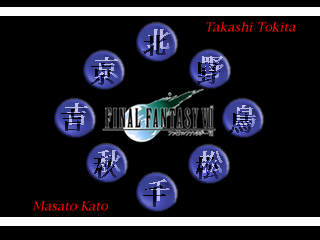
From there, some debug rooms can be accessed while others can’t. The debug rooms are typically black background fields, labelled “BLACKBG” followed by a number or a letter. However, some of these are used in the final game. To distinguish the BLACKBG maps, I complement the table below with color codes.
Default: Map is used in the final game
Blue: Accessible via STARTMAP
Red: Unused Map (not accessible via STARTMAP)
| Field# | Field Name | Signature |
| 93 | BLACKBG1 | Yoshinori Kitase |
| 94 | BLACKBG2 | Motomu Toriyama |
| 95 | BLACKBG3 | Keisuke Matsuhara |
| 96 | BLACKBG4 | Hiroki Chiba |
| 97 | BLACKBG5 | Kazushige Nojima |
| 98 | BLACKBG6 | Jun Akiyama |
| 99 | BLACKBG7 | Kazuhiko Yoshioka |
| 100 | BLACKBG8 | Hideshi Kyonen |
| 101 | BLACKBG9 | Yoshinori Kitase |
| 102 | BLACKBGA | Motomu Toriyama |
| 103 | BLACKBGB | Keisuke Matsuhara |
| 104 | BLACKBGC | Hiroki Chiba |
| 105 | BLACKBGD | Kazushige Nojima |
| 106 | BLACKBGE | Jun Akiyama |
| 107 | BLACKBGF | N/A |
| 108 | BLACKBGG | N/A |
| 109 | BLACKBGH* | Takashi Tokita |
| 110 | BLACKBGI | Takashi Tokita |
| 111 | BLACKBGJ | Masato Kato |
| 112 | BLACKBGK | Masato Kato |
*BLACKBGH is accessed via BLACKBGI, so it is only indirectly accessible from STARTMAP
To reiterate, the map names written in blue are reserved for the Unused Text Series. The remaining unused maps will be divulged here instead.
File Structure & Version Differences
One individual field/map/area in the PlayStation versions has a singular name but is made up of three file types. If you enter FFVII into your computer and check the FIELD folder, you will see the following file types for each map: DAT, MIM & BSX.
By knowing what these are, we can understand more about what the field contains versus what it does not contain. One common element is that a file which is only 2kB (2048 bytes) in size has nothing relevant in itself but nonsense, though there are exceptions.
————————————————————————————————————————
DAT
To use a table from the Qhimm wiki on FFVII data, here is what the DAT file includes:
| Section Name | Section Information |
| Script | Contains conversations, save point interaction, etc. |
| Walkmesh | Contains walkmesh triangles and access info. |
| TileMap | Contains the information for the background, animation and static scene objects. |
| Camera_Matrix | Contains camera info. |
| Triggers | Contains triggers, singles, gateways and so on. |
| Encounters | Battle encounter information for location. |
| Models | Some info about field models. |
In short, DAT is extremely crucial for a functional map. If a DAT file is only 2048 bytes in size, expect it to have nothing of the items listed in the above table.
MIM
The actual background image, or at least most of it, is contained in the MIM file. Without the DAT file to properly arrange the graphic tiles, you won’t get a solid-looking background. Just like DAT, MIM has nothing to divulge if it is merely 2048 bytes big.
BSX
Any field model which is not the main character (the nine playable characters) is contained here. The playable characters are instead contained in separate BCX files, which are not related to any specific field. This is why the BSX file can be below 2kB, but still have the models for Cloud, Barret, Tifa, Aeris, Red XIII, Yuffie, Cait Sith, Vincent and Cid.
————————————————————————————————————————
The file size of the DAT, MIM and BSX in each unused map will be presented. Often data was deleted or changed between releases of FFVII. Here are the abbreviations this article will use for the PlayStation releases:
– JORG: “Japanese Original”. Released on January 31st, 1997.
– JINT: “FFVII International”. Released on October 2nd, 1997.
– ENG: “English Version”. No unused files were changed between the American and (English) European versions.
– Post-JORG: Any edition after the very first Japanese release.
The PlayStation discs have the field files typed in capital letters, which is the system that shall be mimicked in this article. In contrast, the PC version has fields written in lower case letters.
The PC game has all its map inside the “flevel.lgp” file, where each map now consists of one file instead of three. Many unused maps were deleted for the PC port, with the exceptions of the debug rooms and a few others. Unless otherwise mentioned, an unused map is not available in the PC version. All that remains of these maps are their names in an internal map list that the port uses.
The Unused Fields
Thank you for getting through the intro stage to this point. Enjoy the reward!
Map Index
– DUMMY
– Q_5
– BLACKBGA
– BLACKBGE
– BLACKBGF & BLACKBGG
– WHITEBG1
– WHITEBG2
– ONNA_1, ONNA_3 & ONNA_6
– BLIN69_2
– TRAP
– CONVIL_3
– JUNMON
– SUBIN_4
– SHPIN_22
– PASS
– HYOU14
– TRNAD_53
– XMVTES
– FALLP
– M_ENDO
– FSHIP_26
DISCLAIMER: The commentary for these fields includes a lot of speculation, often due to the limited amount of data we have to go on. I hope the reader will find the speculation to be reasonable.
DUMMY

VIDEO:
DUMMY – FFVII Unlocked
ID#: 0
SIGNATURE: Motomu Toriyama
Due to DUMMY not being associated with any specific event, the signature and the map don’t reflect anything that Toriyama was in charge of. DUMMY could just as well have any other signature.
FILE SIZES: The numbers within these tables are the byte size of the file in each respective format and version of FFVII.
| BSX | DAT | MIM | |
| JORG | 17446 | 7142 | 31221 |
| JINT | 17446 | 2048 | 31221 |
| ENG | 17446 | 7169 | 31221 |
Due to the DAT file being only 2kB in JINT, DUMMY is not complete enough to be an explorable field. Teleporting here simply leads to a black space where the game will essentially have frozen. It must be accessed via JORG or the English game.
If you are using an emulator like pSX, the emulator will crash if you try to jump to DUMMY via FFVII International. It is not the case with all unused maps (that have a DAT file of only 2048 bytes) that the emulator will crash. With some examples, all you get is a blank loading screen and nothing more.
DUMMY has no text, so the tiny difference in DAT size between JORG and ENG most likely comes from the latter having support for red/green arrows, while the former does not. The original Japanese release did not include red arrows for gateways and no green arrows for ladders.
The MIM size of 31221 bytes is a standard for all black background fields.
MUSIC: None
WALKMESH: All black background fields use the same type of walkmesh.

The camera has zoomed too far in DUMMY in order to see the player hitting any wall when roaming this field. This is also very common for maps with a simple black background, even in cases where the camera follows the player to some extent. Walkmesh images are taken from Makou Reactor.
FIELD MODELS:
| cloud | ballete | red13 | tifa | cid | earith | boy | avaf |
| Cloud | Barret | Red XIII | Tifa | Cid | Aerith | Shinra Grunt | Jessie |
Aside from “boy” not matching the Shinra Grunt model, all the other romanizations here are quite common in the ID# list for field models. Jessie receives the romanization of avaf (AVALANCHE Female), though in some parts, Wedge receives this codename instead (AVALANCHE Fat?). When Wedge is called avaf, Jessie instead has the name avaw (AVALANCHE Woman).
Unless otherwise mentioned, a field model will have the following animations:
ANIMATION #0: Standing
ANIMATION #1: Walking
ANIMATION #2: Running
Jessie, in DUMMY, is unusual,though, as her zeroth animation is not that of standing, but laying on her back and moving her leg. She also has a “shrug” animation, which, just like the resting animation, is never used by her in the final game. This shrug animation is more commonly associated with Cloud.
All models except for Tifa and the infantryman have as their default to perform an animation repeatedly, while between each repeat resetting to their zeroth animation. All these animations, with Jessie as the exception, are seen in the final game. Only Tifa and the grunt have the three standard animations, while everyone else has a fourth animation which is what they are repeating.
ADDITIONAL COMMENTARY:
Being the very first field of the list and with the name “DUMMY,” it was clearly never intended for the player to visit in the final game. There isn’t much trace of any debugging having been made via this map either.
I speculate that this map was a template from which new fields were made; DUMMY might have been copied, then from that new fields were built. The basic field data is there, without too much having to be deleted.
Q_5 (Fifth Gelnika Room)
All Gelnika maps start with the letter “Q”. This might stand for “Question”, matching with the theme of some monsters here being called “Unknown”.
ID#: 92
SIGNATURE: N/A
Gelnika fields Q_1 through Q_4 expectedly occupy the field IDs of 88-91. Keisuke Matsuhara’s signature is in all of these, so he is assumed to have been in charge of Q_5.




Q_1 ————————————— Q_2 ————————————— Q_3 ————————————— Q_4
In the PC version, the Gelnika files are renamed as follows: qa, qb, qc, qd & qe. The PC version of Q_5 (qe) only exists in the field list, but not as an actual field file.
FILE SIZES:
All file types in all PlayStation versions are 2048 bytes. As was mentioned before, 2048 is the standard byte size when a file is not in any functional state.
ADDITIONAL COMMENTARY:
The used Gelnika maps do not show any obvious unused doors. If a fifth room was ever drawn by Kusanagi or the game’s concept artists, one could guess that it was to be accessed via the bottom of Q_2 or Q_4. Or is that a sealed door on the right wall of Q_3? How fitting that the eerie sunken Gelnika now teases us with its unused map.
BLACKBGA

Motomu Toriyama’s discarded debug room, which was left in favor of his final debug room, BLACKBG2. The unused text of this map will be divulged in a separate article specifically about BLACKBGA. The kanji is often false in this map due to the text being made during an older, smaller build of the game’s kanji table.


BLACKBGA versus BLACKBG2
VIDEO: No release date planned for this video.
ID#: 105
SIGNATURE: Motomu Toriyama
FILE SIZES:
| BSX | DAT | MIM | |
| JORG | 58790 | 10171 | 31221 |
| Post-JORG | 58790 | 2048 | 31221 |
BLACKBGA is one of a handful of maps that can only be visited in the first Japanese release.
MUSIC: Aerith’s Theme CORRUPTED
In an older build of FFVII’s instrumental database, this theme would (presumably) have played in a fashion like in the final game. However, due to additions to the sound data, the one music track of BLACKBGA becomes messed up. Click below to listen.
– Aerith’s Theme ‘Corrupted’
WALKMESH:

Walkmesh is the same between BLACKBGA and BLACKBG2. How the camera follows the player is also identical.
FIELD MODELS:
INVIS stands for “INVISIBLE”.
| cloud | tifa | ballet | earith | guard | dancer | air | cos | ket | crew |
| INVIS | INVIS | INVIS | INVIS | Red Shinra Guard | Honey Bee Girl | Sephiroth | Dark-skinned Costa del Sol Woman | Cait Sith | Sailor |
Either due to having no polygon data or due to the models using an outdated encryption, four characters are invisible here. Moving around with the default player character, Cloud, can be a bit of a hassle, but is made easier if you press select to summon the white glove. Clearly, the map here can not be referring to the BCX character files, which are meant to give the field-specific BSX files some slack. By talking to the invisible models, we can tell that the positions of Aerith, Barret and Tifa in BLACKBG2 matches with BLACKBGA. We don’t know if their field models had special costumes/dresses in BLACKBGA, though.
What is fairly clear is that these models used to be visible. Barret has the setting to perform two animations, jump on the spot three times, then after 120 frames do the same thing all over again. The visible Honey Bee Inn model is the only one that we get to see repeat motions on her spot.
As for animations, Sephiroth and Cait Sith ONLY have their respective standing animation and nothing else. The other visible characters have the three default animations, while the Honey Bee Girl is the only one sporting additional movement, with her turning around and wagging her “stinger” taking up four animations. Nothing else to see, but the animation of the red Shinra Guard walking and running looks a bit primitive because it makes his feet cross each other.
No model has any eye texture. This is consistent with a promotional video for FFVII that shows an early build of the game where many models lack eyes. (See primarily between 01:31-02:41 in the video)
ADDITIONAL COMMENTARY:
With both the text and the music being off due to BLACKBGA being from an older build of FFVII, it becomes a reasonable question if the map jumps available here reflect what they used to be. If you speak to the Costa del Sol NPC and select the first option, the game will send you to SUBIN_4, which is actually another unused map.
The first option has the sign “家”, but by using Asa’s kanji correction key we find that the correct kanji is “街”. This actually matches up with the text in BLACKBG2.


BLACKBGA versus BLACKBG2
This is how we confirm that the map jump to SUBIN_4 is actually wrong. 街 means “town/sector/neighborhood”. In BLACKBG2, this option sends us to the central town area of Costa del Sol. In fact, the girl is completely devoted to map jumps to Costa del Sol in BLACKBG2, while it is the sailor instead who has map jumps to the submarine.
Because of these disparities and the fact that “town/sector/neighborhood” in no way matches up with a submarine area, the map jump to SUBIN_4 can only be a result from the changes to the full field ID list. The same observation can be made for all the other map jumps in BLACKBGA. So, in other words, this scrapped debug room shows its age not only in sound, text and field models, but also in its map jumps. Truly fascinating.
BLACKBGE

The unused text of BLACKBGE was presented at the end of Part 8 and (will be presented in) Part 11 in the Unused Text Series, respectively. For a full text analysis, visit these articles. In brief, BLACKBGE has an unused switch to the second disc and an unused monologue by Sephiroth prior to the battle against his second form.
VIDEOS:
– Bone Village, Forgotten City & Disc Switch – FFVII Unlocked (see 02:05-03:00)
– Final Dungeon – FFVII Unlocked (see 02:32-4:24)
ID#: 106
SIGNATURE: Jun Akiyama
There is no unused map jump to BLACKBGE, not even in Jun Akiyama’s debug room (BLACKBG6).
FILE SIZES:
| BSX | DAT | MIM | |
| JORG | 90 | 7360 | 31221 |
| JINT | 90 | 7385 | 31221 |
| ENG | 90 | 7405 | 31221 |
BLACKBGE also exists in the PC version.
The small DAT difference between JORG and JINT can, again, be bogged down to the added support for red and green arrows.
MUSIC: “Stop Music”
A very short, completely silent music track is often used to silence a previously playing tune. The game has a “stop music” operation code, but it doesn’t appear to be functional.
WALKMESH:

FIELD MODELS:
Cloud is the only field model here. Not even Tifa and Cid are included, which is otherwise the common trinity that’s included in maps. Incidentally, Cloud’s standard three animations (standing, walking and running) have Jun Akiyama’s signature. The small size of the BSX file in BLACKBGE indicates that the Cloud BCX file is referred to instead when his model is spawned.
ADDITIONAL COMMENTARY:
Nothing more to say. Moving on.
BLACKBGF & BLACKBGG

The two fields are grouped together here due to their nigh-identical data.
ID#: BLACKBGF=107, BLACKBGG=108
SIGNATURE: N/A
FILE SIZES:
Both fields have identical file sizes, across all PlayStation versions.
| BSX | DAT | MIM |
| 2048 | 2048 | 31221 |
MIM size corresponds exactly to that of other black background fields, so the background for these maps is no secret.
As was mentioned back in the DUMMY section, jumping to maps with 2kB DAT files will etiher cause the PlayStation emulator to crash or leave you with a never-ending black screen. This suggests that while some of these 2048-byte DAT files are identical in size, their content may be different. Jumping to BLACKBGF will cause the emulator to crash, but not so if you jump to BLACKBGG.
ADDITIONAL COMMENTARY:
Whether BLACKBGF and BLACKBGG were ever reserved for any particular debuggers is difficult to say. It is easy to imagine that many BLACKBG maps were made just to be on the safe side, so that event planners would not run out of maps to experiment in. But BLACKBGG is not the last map on the BLACKBG list, as it continues up to BLACKBGK.
If these two maps were reserved for any particular debugger, there are a number of candidates. The signature “oka” pops up in random fields all over the list, but this oka does not have his own debug room. What is not clear is if this oka is “Kazuhiko Yoshioka” (event planner and whose name matches with the producer of Chrono Trigger) or “Masaru Oka” (a map planner).
The two other candidates would be Takashi Tokita & Masato Kato, who both receive special thanks in the FFVII credits.
WHITEBG1

The unlockable scene in WHITEBG1 will be presented in Part 10 in the Unused Text Series. There is additional text in WHITEBG1 due to it also belonging to a duplicate group, except this text is outdated. This anomaly will be presented in an appendix to the Unused Text Series.
In short, WHITEBG1 holds a more primitive version of the scene that occurs in WHITEBG3 in the final game: The scene where a young Tifa and a young Cloud are found by Tifa’s father and another man.
VIDEO:
– The Lifestream Events – FFVII Unlocked (see 01:28-04:22)
ID#: 113
SIGNATURE: Yoshinori Kitase
The signature matches that of WHITEBG3.
FILE SIZES:
| BSX | DAT | MIM | |
| JORG | 37794 | 11717 | 15746 |
| Post-JORG | 37794 | 2048 | 15746 |
Consistent with the DAT size, WHITEBG1 can only be visited in JORG.
MUSIC: None
WALKMESH: Not just the black background fields, but also the WHITEBG1 and WHITEBG3, use this walkmesh.

FIELD MODELS:
| cl | ti | cid | tcl | Untitled | Untitled | tpa | Untitled | Cloud | Tifa | Cloud | Cloud Clone | Young Tifa | Young Cloud | Tifa’s Father | Man |
The field model list is identical to that of WHITEBG3. The only difference is that in WHITEBG1, Tifa’s father does not have the animations where he partially kneels and scolds Cloud with judging arm motions.
ADDITIONAL COMMENTARY:
Although the kanji is erroneous in WHITEBG1 due to it being from when the kanji table was smaller, when the kanji is corrected, most of the unlockable scene text is the same as the WHITEBG3 counterpart. Only a line by Tifa’s father shows a small disparity with the final result.
WHITEBG2

Some may remember this map and its scene from Part 2 in the Unused Text Series. It’s the unused scene where Cloud has collapsed and the other AVALANCHE members are trying to wake him up.
VIDEOS:
– Sector 7 Events 2/2 – FFVII Unlocked (02:12-02:02:35 for WHITEBG2 scene; watch whole video for full context)
– WHITEBG2 – FFVII Unlocked
ID#: 114
SIGNATURE: Motomu Toriyama
FILE SIZES:
| BSX | DAT | MIM | |
| JORG | 17263 | 8895 | 15746 |
| Post-JORG | 17263 | 2048 | 15746 |
Only possible to visit in JORG? Why of course!
MUSIC: None
WALKMESH:
The area is a square, but with two spikes.
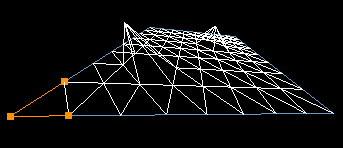
FIELD MODELS:
| cloud | ballet | tifa | avaw | avas | aval |
| Cloud | Barret | Tifa | Jessie | Wedge | Biggs |
Relative to Cloud, all the other field models (except possibly Wedge) have been enlarged. Barret is considerably bigger than the rest. There are no unused animations to spot here.
ADDITIONAL COMMENTARY:
The AVALANCHE basement in the 7th Heaven bar has an unused map jump to WHITEBG2. The intention was possibly to have Cloud collapse after having first gone down via the pinball elevator.
ONNA_1, ONNA_3 & ONNA_6 (Honey Bee Inn)



All the secrets of the unused Honey Bee Inn maps are divulged in page one and two of The Unused Text Part 4. Hopefully the article will receive an update in the future, where the final kanji corrections and some re-retranslations can be made.
ID#: ONNA_1=215 , ONNA_3=217 , ONNA_6=221.
SIGNATURE: Motomu Toriyama
FILE SIZES:
| ONNA_1 | BSX | DAT | MIM |
| JORG | 60367 | 16594 | 220021 |
| Post-JORG | 60367 | 2048 | 220021 |
| ONNA_3 | BSX | DAT | MIM |
| JORG | 24492 | 10029 | 240548 |
| Post-JORG | 24492 | 2048 | 240548 |
| ONNA_6 | BSX | DAT | MIM |
| JORG | 13703 | 11108 | 260669 |
| Post-JORG | 13703 | 2048 | 260669 |
ADDITIONAL COMMENTARY:
With the current edition of Makou Reactor, it is now possible to create new gateways in the unused Honey Bee Inn maps. Normally these are prison fields, but now this can be amended if you desire to mod these fields back into the game. To mod these into the English game, all you need to do is place the appropriate ONNA DAT files into the English game. The only downside is that red triangles will appear at random spots. Because the JORG DAT files do not have support for red arrows, these can’t be adjusted to fit the locations. The modding tools to fix this do not currently exist.
BLIN69_2 (Shinra Building, 69th Floor)
BLIN69_1 is the area where Tifa stays behind to wait for Cloud, while Barret and Red XIII attempt to escape with Aeris. There is no additional “BLIN69” field used in the final game. BLIN69_1 contains in itself both the “blood” and “no blood” versions (due to the blood being an animation parameter).
ID#: 265
SIGNATURE: N/A
FILE SIZES:
All files are 2048 bytes in size in all PlayStation versions.
ADDITIONAL COMMENTARY:
We can do some reasonable speculation on what BLIN69_2 might have looked like. The map name extension “_2” is used throughout the floors of the Shinra HQ fields. While for example BLIN60_1 shows the full floor, BLIN60_2 zooms in on the elevator doors on that floor.


BLIN60_1 ————————— BLIN60_2
The 67th floor is another example.


BLIN67_1 ————————— BLIN67_2
This pattern is true for a total of seven floors in the Shinra HQ. If this holds true for the unused field, then we can imagine for ourselves which section of BLIN69_1 we might need to zoom into in order to get BLIN69_2.
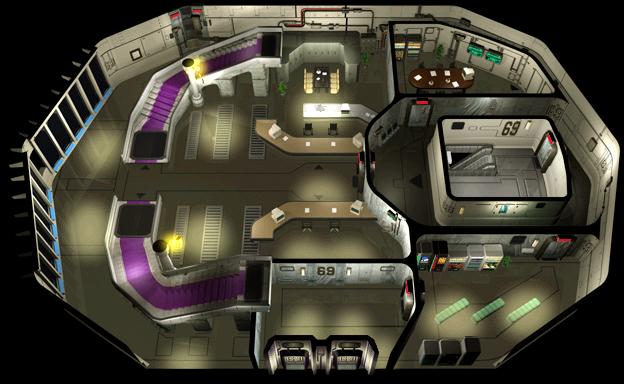
TRAP
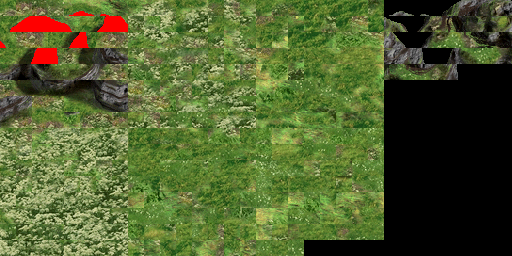
The above image is a texture rip with all the graphic tiles in their default order, courtesy of Makou Reactor creator Myst6re.
ID#: 346
SIGNATURE: N/A
FILE SIZES:
File sizes are the same in all PlayStation versions.
| BSX | DAT | MIM |
| 2048 | 2048 | 119318 bytes |
Because the DAT file is incomplete, the background tiles in MIM are not arranged properly. What might TRAP look like when restored to its original form?
ADDITIONAL COMMENTARY:
Some of you may wonder what is up with the red portions among the tiles.
A background in FFVII usually consists of two layers. Often, one layer shows the sections that can be overlaid on the playable character, to make it appear like they are standing behind an object. When both layers are on top of each other, the full picture is formed. Let’s use the FARM field as an example.
 PLUS
PLUS  EQUALS
EQUALS 
This is why we have the red sections in the TRAP texture rip. One can spot how the red shapes match some of the rock tiles in TRAP, meaning that some tiles are meant to be laid over others.
Final Fantasy VII veteran BrutalAl found that a logical pattern actually dictates how the tiles are grouped in the rip of the TRAP MIM file and used this knowledge to restore the field image. For the first time since developers worked on the game over 17 years ago, human eyes can yet again gaze at the TRAP background.
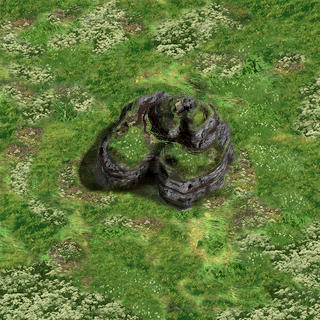
With the size of 320×320, we can see that without zoom it matches FFVII’s default resolution of 320×240. This means that if you roamed this field inside the game, you would get some scrolling on the up-down axis. Judging from the tiles with red in the texture rip, the player was able to partially hide behind the top and the sides of the rock formation.
How BrutalAl restored the map:
The direct rip can be divided into 6+1 groups of tiles, as is immediately visible. Group 7 (top right) is an obvious “foreground layer”. The first step was to confirm if there were enough tiles in the six groups to fill a whole square without there remaining an uneven number of tiles at the end.
6 (number of tile groups) * 64 (tiles in each group) – 5 (the 6th group has five tiles fewer) + 21 (include the completely “empty” tiles that are behind group 7) = 400
400 is a convenient number. It can create an image of 10*40, 16*25 or 20*20. This also means, with great likelihood, that the picture is completely without animations.
Contrary to what some might assume, the tiles in each group are NOT randomly mixed. They are placed in an order that is used for the final field image/map. The tile at the top left in a group will always be used BEFORE the second tile on that row, the second tile will always be used before the third and so on in that group.
This also means that the first tile in the final image must be Tile #1 either from group number 1, 2, 3, 4, 5 or 6. Let us say that Tile 4-01 (Group 4 Tile 01) is supposed to be at the top left in the final image. The tile to its right could yet again be one of six possible, either 1-01, 2-01, 3-01, 4-02, 5-01 or 6-01. Earlier we found the necessary dimensions to make use of the 400 tiles, so through that we know that the row will end either on tile 10, 16, 20 or 25.
Once the first row was completed the process became much easier, because then the “next” tile could always be matched with two other tiles (the one to the left and the one above).
After three hours of active work, BrutalAl solved the TRAP puzzle. Time was saved by having Photoshop “create” numbered tile pieces for him, automatically.
But what events were TRAP meant for? In general, the fields are listed in a way that represent the player’s progression through areas in the game’s story. Key term being “in general”. The context of TRAP is that it’s placed right after the Chocobo Farm maps, but right before FR_E and SICHI.


FR_E (ID#347) ——— SICHI (ID#348)
FR_E ended up used on the second disc event instead, right after the team encounters Diamond Weapon. But let’s continue the speculation anyway. Being positioned right after the Chocobo Farm fields, could it be that your task was to catch Chocobos via TRAP instead of the overworld?
It is not farfetched to think that TRAP was the original field where Yuffie was to be recruited to your team. Was Yuffie to set up a trap for our heroes? I argued for Yuffie’s scrapped, early recruitment in Unused Text Part 6, after noting that Yuffie can be present when the team reacts to the impaled Midgar Zolom. Here is that segment from the article.
Yuffie’s presence can be explained by the theory that originally she was meant to be recruitable earlier on. In the Character Files section of the FFVII Ultimania Omega’s Early Material Files, the recruitment info says that Yuffie was to be available any time after passing Kalm.
Semantics can argue that the earliest window in the final game to recruit her, which is after passing through the Mythril Mines (when you get to the first forest patches), is technically after Kalm, but the Ultimania passage is still arguably suggestive.
Also take into account the odd fact that even though you battle Yuffie in a forest, the scene that follows takes place on a grassfield with no trees in sight. This item, too, is with a counterpoint, specifically that the party may have dragged her out of the forest for reasons unknown, but the combination of this odd transition and the recruitment info in the Early Material Files adds credence to the notion that originally Yuffie was to be encountered on the grassy fields. In this scrapped framework, she would have been naturally present in the scene with the impaled Midgar Zolom.
The final game’s field where Yuffie is recruited is YOUGAN2, which is placed after Rocket Town but before Wutai in the map list. The fields where Yuffie can steal your materia are in YOUGAN and YOUGAN3, which lay adjacent to YOUGAN2 in the table.
Without additional data, we have to end our speculations here.
CONVIL_3 (Fort Condor)
Although the place is called Fort Condor, the file name clearly stands for “Condor Village”.
ID#: 357
SIGNATURE: Kazuhiko Yoshioka
Yoshioka was also in charge of the Fort Condor minigame.
FILE SIZES:
Data size is the same in all PlayStation versions.
| BSX | DAT | MIM |
| 7785 | 2048 | 2048 |
Despite the DAT file being only 2048 bytes, there is readable text if you open it in any text document (be it Word or Notes). This string only appears in the JORG version of the DAT file. This here is what we see:
| kyoshio convil_ init cloud ballet tifa earith red yufi ketcy vincent cid |
In all other cases in the field list, Kazuhiko Yoshioka writes his signature as “yosioka”. This is the only time we see it written as “kyoshio”. It is thanks to this unusual DAT file that we can list the map’s signature with hundred percent certainty.
“init” is commonly the first item on the field’s ID table (followed by data for background animations and field models), as it decides what the map should do when it loads. An init group can be found in all CONVIL fields. There is a space between convil_ and init, so the two are probably not meant to be linked.
In the remaining string we see recognizable romanizations for the names of the main playable characters. Whether the BSX file actually contain field models corresponding to these names or something completely different, is unknown. If the BCX character model files were the only thing referred to the BSX file in CONVIL_3 would be considerably smaller. My guess is that this field model data uses the outdated encryptions for the main characters, like what might be the case in BLACKBGA.
ADDITIONAL COMMENTARY:
We actually have two confident guesses as to what CONVIL_3 looked like. First, we round up the used fields.

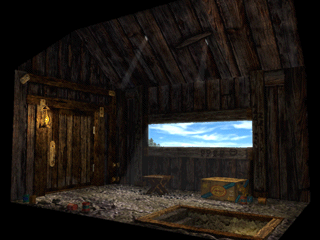


CONVIL_1 —————— CONVIL_2 (default) —————— CONVIL_2 (animation) —————— CONVIL_4
When speaking to the NPC in the cabin, you can activate the CONVIL_2 animation and get to see the condor. This image is similar to the condor/phoenix FMV, but not identical with any frame from that sequence.
Don’t forget that we also have a minigame where a Fort Condor map is roamed.
While the CONVIL_2 view of the condor is a candidate for CONVIL_3, I place my bet on the minigame map to have once been CONVIL_3. Initially the minigame may have been planned to take place on a normal field map, but was then moved to the minigame folder.
The minigame map rip is from the PC version, from the condor.lgp file in the minigame folder. The equivalent file in the PSX version has to be in either the CONDOR.BIN file or one of the CONDOR.LZS files. Without proper tools to extract these, I am not sure which holds the minigame map.
JUNMON
The map is fittingly grouped with other Junon fields. The only file name interpretation I can think of is “Junon Monster“.
ID#: 403
SIGNATURE: N/A
Yoshinori Kitase is the best guess for this field. Read further below.
FILE SIZES:
All files are 2048 bytes in size in all PlayStation versions.
ADDITIONAL COMMENTARY:
The file name and the interpretation of it leads one to think of Sapphire Weapon’s attack on Junon on the second disc. The placement of JUNMON in the field list fits, as it is placed right after the “JUNBIN” fields where the Weapon events in Junon take place. Yoshinori Kitase handled that scenario and his name might belong to JUNMON. All the other Junon events were handled by Toriyama.
I speculate that JUNMON was to act as a transitional field into one of the Sapphire Weapon FMVs. The final game sometimes uses transitional maps, even when not necessary, for some FMVs. For example the FMV showing Junon begins after first loading the JUNON field.
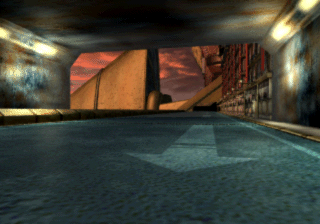
The walkmesh and the field models therein are used as the transition. The FMV triggers so quickly that the player never actually gets to see the JUNON map loaded; they only see its FMV counterpart.
So, perhaps a snapshot from one of the Sapphire Weapon FMVs could be what JUNMON looked like?
SUBIN_4 (Inside Submarine)
This is the unused map we saw referenced in BLACKBGA. This is the only map jump to SUBIN_4 in the entire game.
ID#: 410
SIGNATURE: N/A
Motomu Toriyama was most surely responsible for SUBIN_4, seeing as he handled all the other submarine fields and the submarine minigame.
FILE SIZES:
All files are 2048 bytes in size in all PlayStation versions.
ADDITIONAL COMMENTARY:
For completion, let’s list all the SUBIN fields that the final game employs. The red submarine is only visited if you lose in the submarine mission, which leads to the grey sub being destroyed.



SUBIN_1B ———————— SUBIN_2B ———————— SUBIN_3


SUBIN_1A ——— SUBIN_2A
When losing the submarine minigame, the team enter SUBIN_3. They then launch themselves out of the malfunctioning submarine by riding on a torpedo. This odd scenario where they launch themselves out is never actually seen. SUBIN_4 could be an area accessed from SUBIN_3, perhaps after Cloud opens the door on the upper right of SUBIN_3.
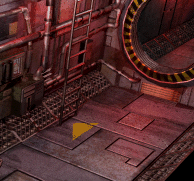
Entrance to SUBIN_4?
There exists no gateway data to prove this notion though. Grouping SUBIN_4 with the grey submarine would fit though. If this unused map belonged to the red submarine, one would have expected SUBIN_3 to be called “SUBIN_3B” and SUBIN_4 to be “SUBIN_3A“.
It is of course still possible that SUBIN_4 belongs to the red submarine. While the red tone of SUBIN_3 fits with the dangerous scenario in which it is visited, the color scheme fits better with the red submarine. Is SUBIN_3 the original SUBIN_4, with SUBIN_3 originally having a color scheme that fit the grey submarine?
Pardon the lengthy speculations. As a finishing note on the submarines, both SUBIN_2B and SUBIN_2A have the unused animation to “access” the ladder which leads down to another area. In the grey submarine’s case, this area is, of course, SUBIN_3. This doesn’t prove that the red submarine was to have an additional field, but it’s still an interesting observation.

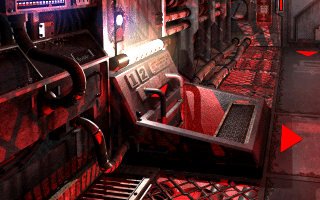
SHPIN_22 (Cargo Ship Storage Room, Empty)

The general shape of SHPIN_22 is identical to the cargo-filled version of this field, SHPIN_2. It was briefly mentioned near the end of the first page of Unused Text: Part 6, due to having an unused location name. This location name, “Cargo Ship”, will not display even if the menu is accessed, though.
Because the map only consists of one layer, no part of the background ever obscures the playable character. If you remember the lessons from TRAP, this concept will be familiar.
VIDEO:
– SHPIN_22 – FFVII Unlocked
ID#: 438
SIGNATURE: Jun Akiyama
FILE SIZES:
| BSX | DAT | MIM | |
| JORG | 193 | 5630 | 166424 |
| JINT | 193 | 5654 | 166424 |
| ENG | 193 | 5658 | 166424 |
The low size of the BSX file is consistent with the map. Although it has the field models for all nine playable characters, we can assume that the game here is referring to their respective BCX file and is, thus, saving space for BSX.
SHPIN_22 can also be visited in the PC version.
MUSIC: None
WALKMESH:
We shall compare the walkmesh of both the unused and used cargo rooms.


SHPIN_22 versus SHPIN_2
What is interesting is that SHPIN_2 actually has an unused gateway. If you enter an area to the southeast, far away from the walkmesh, jumps to the Junon dock exists. If the cargo ramp was out, like it is in SHPIN_22, there might have been hope of reaching the gateways to the Junon dock.
FIELD MODELS:
| CLOUD | EARITH | BALLET | TIFA | RED | CID | YUFI | KETCY | VINCENT |
| Cloud | Aerith | Barret | Tifa | Red | Cid | Yuffie | Cait Sith | Vincent |
Only the standard three animations are possessed by all these characters.
ADDITIONAL COMMENTARY:
The most common and sensible theory is that SHPIN_22 was to be used as a transitional field for parking your buggy. Whether any unused map jumps to SHPIN_22 exist in the world map data, however, I can’t say for certain.
All cargo ship fields, with one exception, have Jun Akiyama’s signature. The exception is SHPIN_2, which has the rare signature “iriguch”. This one only appears in three fields in the entire game. Who is this “iriguch”? It might be Junko Iriguchi (Map Planner) or Murasaki Iriguchi (Character Modeler).
PASS
Passageway? Mountain pass? Overpass?
ID#: 571
SIGNATURE: N/A
FILE SIZES:
All files are 2048 bytes in size in all PlayStation versions.
COMMENTARY:
The context of PASS is that it is placed after the final Rocket Town (or specifically, the rocket itself) map, but before the Wutai fields.
| ID#570 | RCKTIN8 |
| ID#571 | PASS |
| ID#572 | YOUGAN |
| ID#573 | YOUGAN2 |
| ID#574 | YOUGAN3 |
| ID#575 | UTA_WA |
YOUGAN or YOUGAN3 is employed for when Yuffie steals your materia. YOUGAN2 is for recruiting Yuffie and UTA_WA is the Wutai weapon store.
With this context, we get a hint that PASS belongs either to Rocket Town or Wutai. If it stands for “passageway”, then it could fit for an area in Rocket Town or the rocket itself.
The western-most continent is very mountainous, so “mountain pass” is a readily available interpretation. Remember also the three bridges you walk across from mountain to mountain on this continent. The bridge might have been an “overpass”.
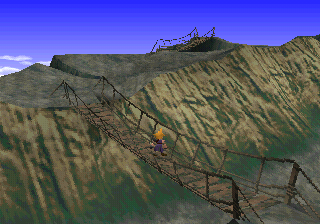
Was PASS to be visited instead of these bridges?
HYOU14 (The Great Glacier)
The word “hyou” is a Japanese word for hail (ice rain). All Great Glacier maps except for two ice caves are called HYOU and may mean to say that the ever-blowing blizzard is the “ice rain”.
The Great Glacier fields are all part of one big duplicate group, and so they all have the same text. Each file has the location name “Great Glacier” repeated 21 times, but only 20 of those text entries are ever used. One of them remains unused. Could it belong to HYOU14?
ID#: 685
SIGNATURE: N/A
Kazuhiko Yoshioka was responsible for the Great Glacier areas, so his name most likely belongs here.
FILE SIZES:
All files are 2048 bytes in size in all PlayStation versions.
ADDITIONAL COMMENTARY:
There is actually promotional material for FFVII that might show us what HYOU14 looked like. In an FFVII archive dating back to August 1, 1999, we find the following background render.

Two years later, the same image and two more surfaced on RPGamer, grouped under the “Nibelheim Mountains” pictures, oddly enough.

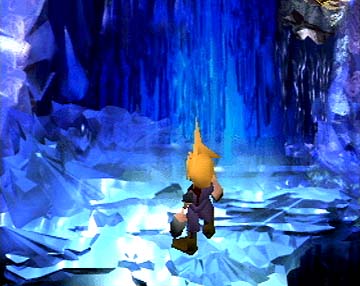
These renders and snapshots are most certainly the real deal. Where these pictures are originally from I do not know, but they have appeared in other promotional material. For example, in a poster from issue #78 (May 1997) of the “Ultra Game Players“, this unused cave is shown. FFVII collector Rob64Strife acquired this magazine and its poster, which he then showcased in his first Final Fantasy VII Promo’s video. See the cave at 3:14.
The golden boxes appear to be an exotic type of treasure chest. However, it looks like the game would not allow Cloud to reach the treasure from the point where he is seen standing.
The most obvious theory is that this unused cave is related to the two ice caves of the Great Glacier.


ICEDUN_1 ——————————— ICEDUN_2
In the final game, when reaching ICEDUN_2 via ICEDUN_1, you have the option to leave the Great Glacier. Taking the “ice slide” which makes Cloud roll around will throw Cloud into a hole and suddenly you find yourself back on the world map. Doesn’t make much sense, does it?
It is very intuitive to imagine that rolling in ICEDUN_2 would take you to the unused ice cave, where it would then be up to the player to jump off the slide at the right point in order to reach the two golden treasures.
Look also at the bottom right of ICEDUN_1. In the final game it leads nowhere but visually it looks like the perfect transition into the bottom of the unused cave.
One of the only holes in this theory is the oddity that the unused map is called HYOU14 and not “ICEDUN_3”. Keep in mind, though, that there are four other Great Glacier caves which also carry the name “HYOU”. It would feel better, of course, if HYOU14 was grouped right next to the ICEDUN fields, but the ID number of HYOU14 is 685; quite a stretch away from ICEDUN_1 and ICEDUN_2, which are numbered 661 and 662 respectively.
Remember also that among the location names, only the “Great Glacier” name is unused. There is no third, unused location name for the ICEDUN caves.
While it is tempting to think of HYOU14 being the scrapped ice cave, it is still possible that a field file called ICEDUN_3 was deleted at some point. As to why the additional ice cave was removed, perhaps it was deemed too colorful for the Great Glacier. While some maps did receive great changes during development, we simply have to conclude that the time was not taken to retouch the cave.
TRNAD_53

The unused text and code of this map was revealed in The Unused Text: Part 9. All speculation surrounding this field is also presented there.
VIDEO:
– Northern Crater Disc 2 Events – FFVII Unlocked (see 02:09-03:41)
ID#: 708
SIGNATURE: Kazushige Nojima
FILE SIZES:
| BSX | DAT | MIM | |
| JORG | 24373 | 11353 | 312622 |
| JINT | 24373 | 11379 | 312622 |
| ENG | 24373 | 11386 | 312622 |
This map can also be visited in the PC version.
MUSIC: Aerith’s Theme
WALKMESH:
Finding proper camera angles was not easy, but the walkmesh can be summarized as having a portion for where the Sephiroth cocoon is, with two small paths below it.

Then, at the very bottom, we have the area that the player can traverse if they activate movability when visiting this map.

FIELD MODELS:
| cloud | tifa | ba | red | yufi | ket | vin | cid | LUFAS | skaret | hojo |
| Cloud | Tifa | Barret | Red XIII | Yuffie | Cait Sith | Vincent | Cid | Rufus | Scarlet | Hojo |
All these field models only have the standard three animations of standing, walking and running.
ADDITIONAL COMMENTARY:
Like is mentioned in Part 9 of the Unused Text series, TRNAD_53 was most likely intended as a transition to the FMV where Sephiroth’s cocoon descends. This FMV, titled C_SCENE2, begins with the TRNAD_52 view instead, placing the TRNAD_53 perspective later. Perhaps this second portion was its own FMV originally, which was then grouped together with the first bit. This type of FMV editing is, in fact, very relevant for our next unused map…
XMVTES (Inside the Planet, FMV Test)
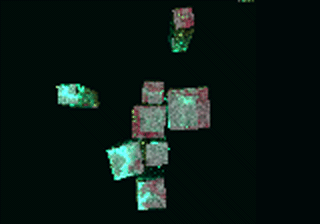
VIDEO:
– XMVTES – FFVII Unlocked
ID#: 743
SIGNATURE: Hiroki Chiba
FILE SIZES:
| BSX | DAT | MIM | |
| JORG | 6787 | 5088 | 20191 |
| Post-JORG | 6787 | 2048 | 20191 |
Consistent with earlier examples, given the DAT size, XMVTES can only be visited in JORG. The map begins by playing its only music track and by trying to play an FMV.
With Cloud’s default position in the field, the game will freeze whenever a directional button is pushed. This can sometimes happen if a character model is placed somewhere that the game, for whatever reason, dislikes. The freeze will cause the music to hang on whatever tone it is playing at the moment.
In order to best roam this map, one should teleport straight to the walkmesh.
MUSIC: “Hurry Up!”
WALKMESH:

The bottom section exists outside of view for the player, so the bottle neck will only be noticed with walkmesh viewers or by changing the camera position. The movement orientation for the player is quite off, with each directional button translating to diagonal movement instead of up-down or left-right.
This walkmesh is actually identical that used in LAS4_4 and LAS4_42. These two fields are visually identical, but used for different things: LAS4_4 is used for the encounter with Jenova while LAS4_42 is used as a transition to the FMV where the area breaks apart.
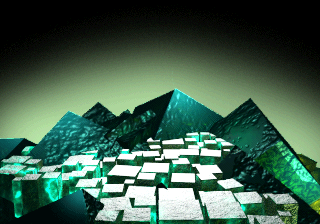
These maps “Inside the Planet” on your way to Jenova use a “shade” effect for the small floating islands. The code for this type of effect exists in XMVTES as well, but there is not enough image data to manifest this effect.
FIELD MODELS:
| cloud | ballet | tifa | red | cid | yufi | cait | vincent | Cloud | Mechanic | INVIS | INVIS | INVIS | INVIS | INVIS | INVIS |
Just like in BLACKBGA, we now have field models which are not visible at all. Barret’s spot also happens to be taken by one of the engineers/mechanics from Cid’s rocket. Due to XMVTES being a field for testing, there might be some humor behind the idea of having a mechanic NPC in this map.

ADDITIONAL COMMENTARY:
The name interpretation of XMVTES into “FMV Test” is justified both by the visuals of the field and its contents. XMVTES is trying to play an FMV, but if entering here on the third disc (as was intended) then the game can’t find an FMV where it is searching. The same phenomenon occurs in BLACKBGE. The cause is most surely due to changes in the full FMV list. By moving two steps in the list, we make XMVTES find the FMV of “LAST4_4” which is activated in LAS4_42 in the final game.
What we find is the the XMVTES background matches best with the very first frame of the second portion of the LAST4_4 sequence.


The conclusion is that LAST4_4 used to begin with this frame, but was then adjusted to include the first perspective. Quite neat to see how FMVs were edited and lengthened, isn’t it? The primitive appearance of XMVTES makes us wonder if this is an image from the FMV early in development or if some partial, poor render is what we are seeing.
FALLP (Fall Parachute or Fall President)

VIDEO:
– FALLP – FFVII Unlocked
ID#: 769
SIGNATURE: Yoshinori Kitase
FILE SIZES:
| BSX | DAT | MIM | |
| JORG | 5331 | 10169 | 45397 |
| Post-JORG | 5331 | 2048 | 45397 |
Even though FALLP can only be visited in JORG, astoundingly enough the background itself can be viewed in other versions. It will not work in current versions of Makou Reactor, but background viewers like 7mimic will display FALLP even when using versions like FFVII International or the English game. Clearly, the DAT file has enough data to organize the graphic tiles despite being only 2048 bytes in those versions. FALLP is a true exception in this regard. If only TRAP was the same…
FALLP belongs to a duplicate group, but contains outdated text. This is similar to the WHITEBG1 case, except here there is no erroneous kanji. The quirks of this text will be revealed in an appendix to the Unused Text Series.
MUSIC: None
WALKMESH:

If you jump to origo (the spot where all coordinates have a value of zero) in FALLP the player will end up on the northern walkmesh, some distance away from the actual background image. What is curious about this area is that the walkmesh is identical to that of MD8_5 and MD8_52. The former map is used for when Cloud and team parachute down to Midgar, while the latter is used for when Diamond Weapon’s energy shells fly toward Shinra HQ.

This connection continues in Yoshinori Kitase’s debug room, BLACKBG1. A text option via Red XIII normally sends you to MD8_52 and its default sequence, followed by the FMV where Shinra HQ gets blasted. However, adjacent to the MD8_52 jump exists an unused map jump to FALLP. If we remove the jump to MD8_52, the game will take us to the southern walkmesh of FALLP where one can properly walk on the background.
Trivia: In JORG, MD8_52 is the very last map in the field list. Post-JORG the maps for a train station and the ‘Zack Flashback’ scenes were added.
FIELD MODELS:
| cl | ti | cid | be |
| Cloud | Tifa | Cid | Diamond Weapon Energy Shell |
The trinity of the playable leaders is expected, but the “be” model may not be expected going from the map name and the background alone. What “be” stands for is uncertain, but it is the same type of energy shell seen in MD8_52, which has a total of six be models.

ADDITIONAL COMMENTARY:
If we had only the field name and the map to go on, one would think that FALLP was to act as a transitional field to the FMV (PARASHOT) where Cloud and team parachute down to Midgar. In this theory, the FMV might not have included the first portion where we see the characters falling down from the Highwind. The FMV would also have to start a bit later, as FALLP actually matches the 21st frame of this second portion of the PARASHOT FMV, rather than its very first frame.


*Each frame in the PSX FMVs hold the ghost of its previous frame, ergo why the Highwind is partially visible in the image to the right.
But thanks to additional discoveries we know that FALLP is directly linked to the sequence prior to Rufus Shinra’s seeming demise. With the walkmesh from MD8_52 and the Diamond Weapon energy shell, I speculate that FALLP was to act as a transition to the FMV (CANONH3F) where the top floor of Shinra HQ gets struck by the energy blast. This FMV obviously would have been a bit different, as this top-down view of Midgar never happens in CANONH3F. FALLP might also have been a temporary map for testing some of the effects we see in MD8_52.
There is still the possibility that FALLP is a snapshot from the FMV specifically titled “PARASHOT” in the final game, so FALLP could still be read as “Fall Parachute”. If this was not the intended meaning, then FALLP might stand for “Fall President”, as in “The Fall of President Rufus Shinra”.
M_ENDO
M_ENDO might stand for “Midgar End Of” or “Meteor End Of”.
ID#: 770
SIGNATURE: N/A
FILE SIZES:
All files are 2048 bytes in size in all PlayStation versions.
COMMENTARY:
We can be certain that this is a Midgar map. All other fields that begin with the letter M are either a mountain (MT_) or Wall Market (MKT_ or MRKT_). Due to the lack of additional letters to match with either a mountain or Wall Market, Midgar is the only interpretation left.
Going off our interpretation of the file name, it may be that M_ENDO was to be used for the game’s final scenes. Maybe it was not clear from the start that the ending scenes would all be rendered into movies, and so M_ENDO was a map meant to hold some normal gameplay for the ending? Maybe it would have shown the evacuation of Midgar citizens? This is, of course, wild speculation.
I have nothing to support this, but it is my personal speculation that M_ENDO looked like the two “Sector 0” maps. Possibly it was even a copy of MD_E1, but reserved for other scenes.


MD0 ————— MD_E1
FSHIP_26
The name FSHIP is used for all Highwind fields and probably stands for “Flying Ship”.
ID#: 776
SIGNATURE: N/A
It is worth noting that Kazushige Nojima handled eight of the used Highwind fields while the remaining three has Hideshi Kyonen’s signature.
FILE SIZES:
All files are 2048 bytes in size in all PlayStation versions.
COMMENTARY:
All maps showing the Highwind bridge have the name FSHIP_2, with or without an added number. They all look the same (with the exception of FSHIP_22, which has a distinct blue tone), but have code for different scenes. The used maps occupy field IDS 68 through 72.

FSHIP_2: Contains unused scene where the party talks about “What Cloud Is”, and is also used for the final Highwind scenes on Disc 2.
FSHIP_22: Shinra executives scene. Triggered in the Whirlwind Maze.
FSHIP_23: When Tifa or Cid is leader.
FSHIP_24: Only accessed for scenes when the team observes that the barrier at the Northern Crater is gone and just before you parachute down into Midgar.
FSHIP_25: For most scenarios when Cloud is the leader, including the Highwind on Disc 3.
So what is the deal with FSHIP_26, being placed so far away from its siblings in the field list?
FSHIP_26 belongs to a group of fields which exist beyond the maps for the final dungeon. Remember the general pattern that fields are listed in the order that they are encountered throughout the game’s plot? In order to prevent screw-ups with the map jumps, like we saw in BLACKBGA, these fields were added to the final segment of the field list rather than to the middle of it.
These are those maps:
| ID# | Field Name | Event/Purpose |
| 769 | FALLP | See FALLP section in this article. |
| 770 | M_ENDO | Unknown. |
| 771 | HILL2 | Tifa waking up wtih Cloud beneath the Highwind, then walking back to the ship. |
| 772 | BONEVIL2 | Map for the Bone Village minigame. |
| 773 | JUNONE7 | Cloud observes that something is missing from Junon. It’s the cannon. |
| 774 | RCKT32 | Palmer battle and transition to “Tiny Bronco Flies Off” FMV. |
| 775 | JTEMPLC | Ancient Temple: Cloud giving Black Materia to Sephiroth. Zoom-out map is JTEMPLB. |
| 776 | FSHIP_26 | Unknown. |
| 777 | LAS4_42 | Transition to FMV where area falls apart after final Jenova battle. |
| 778 | TUNNEL_6 | Final encounter with the Turks. |
| 779 | MD8_52 | Diamond Weapon energy blasts flying by. |
With this knowledge, FSHIP_26 could belong to any number of categories. It could be a “zoom-in” field, like JTEMPLC is when compared to JTEMPLB. It could be a transition to an FMV or even the intended spot for some normal gameplay scenes during the game’s ending sequences, before the final scenes were rendered into movies only. Maybe an event planner thought that an extra FSHIP_2 map would be needed for some of the bridge scenes we already know, then decided to use the old FSHIP_2 maps instead.

Maybe FSHIP_26 was a transition to a scene like this from the ending?
That ends the summary of the unused fields of FFVII that can be found in the game’s FIELD directory. Now for some observations about the “hinted lands” not actually present in the retail edition, plus an easter egg that can be found in the actual game.
Field Name Dissection & Easter Eggs
When modding a game or just viewing its files, your perspective of the game inevitably changes. After I have spent countless hours with FFVII’s FIELD folder, I can easily tell from the file name which game area it corresponds to, among other things. To complement this article and the Unused Text Series, I will in the not-too-distant future publish an article entitled “FFVII: Field List & Author Documentation“. For those patient enough to read that feature when it comes, they may hopefully feel just as home with the FIELD folder as I do. It is the purpose of these articles to make the reader feel familiar with the FFVII files in a way as similar as possible to those who actually view these files for hours on end.
There is always more stuff to research and more modding to be done, some which may justify updates to this and other articles. Your best bet if you want to keep up with these edits is to frequent TheLifestream.net forums. For example I can’t say for certain if all the 2kB DAT files are without readable text. It might be that when the game’s Japanese tables are applied (be it the old or new kanji tables) something is revealed. To me, this is currently unknown.
One observation that did not quite fit anywhere else is an oddity from the English European/PAL version of FFVII. This field folder actually holds a copy of a used Chocobo Farm field! FRCYO is the map for the Chocobo stables. The PAL version holds this and a copy called “FRCYO2”. Technically, this map is unused, but it causes no glitches, presumably because its field ID is the same as FRCYO. I can only imagine FRCYO2 existing as a mistake.
There are, of course, more random observations to be made when viewing the full field list. Remember the two sewer fields from after Don Corneo activates the trap door? These are titled COLNE_B1 and COLNE_B3 (Corneo_Basement) respectively, but there is no intermediate COLNE_B2 in sight. Was a map deleted or was the number 3 accidentally typed when the second map should have been called COLNE_B2? We obviously do not know.
There are also examples like with Mt. Nibel or Junon. The fields MTNVL2 up to MTNVL6 (and MTNVL6B) exist, but there is no MTNVL1 or MTNVL in sight. Deleted map or odd naming choice? There is also the JUNONE series from Junon: JUNONE2 through JUNONE7 exist, but no JUNONE1 or JUNONE is present. We can only speculate on whether inconsistent naming or deleted maps is the cause.
On the topic of unused maps, albeit not ones that are actually found in the FIELD folder, the Gold Saucer is kind enough to show us some unused concept art for FFVII maps. The Wonder Square has a television with constantly changing images. If the player is patient enough, one concept art piece will show up. It can also be viewed on the FFVII International bonus disc and in various FFVII art books.

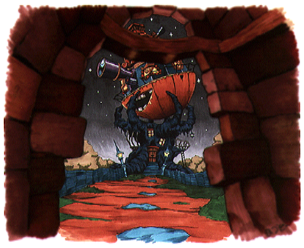
A second image from the Wonder Square might be an initial concept for the Ghost Hotel, judging from the silhouette that is reminiscent of the Ghost Hotel.


I hope that with this article I have adequately presented the perspective one gains of the unused maps of FFVII when coupled with some technical knowledge about the game. Thanks for reading!
Credits, Sources & References
– This article was inspired by Robert Seddon’s blogpost Hinted Land, posted in 2008.
– To all who have contributed to the Unused Text Series: Thank you!
– The Qhimm wiki for info on the Field File Formats.
– Thanks to Myst6re for creating and always updating his software, Makou Reactor. Additional thanks for providing the TRAP texture rip.
– BrutalAl for restoring the TRAP field image using said texture rip.
– Lasyan3 for creating MassFieldUpgrade, with which changes to the PlayStation field files can be inserted into the main game.
– JBedford128, for help on how to extract Fort Condor minigame data.
– Background viewer 7mimic.
– Last, but not least: Thanks to everyone who appreciate these articles!

